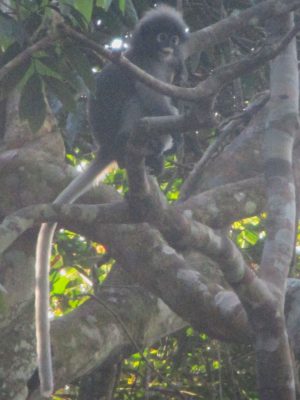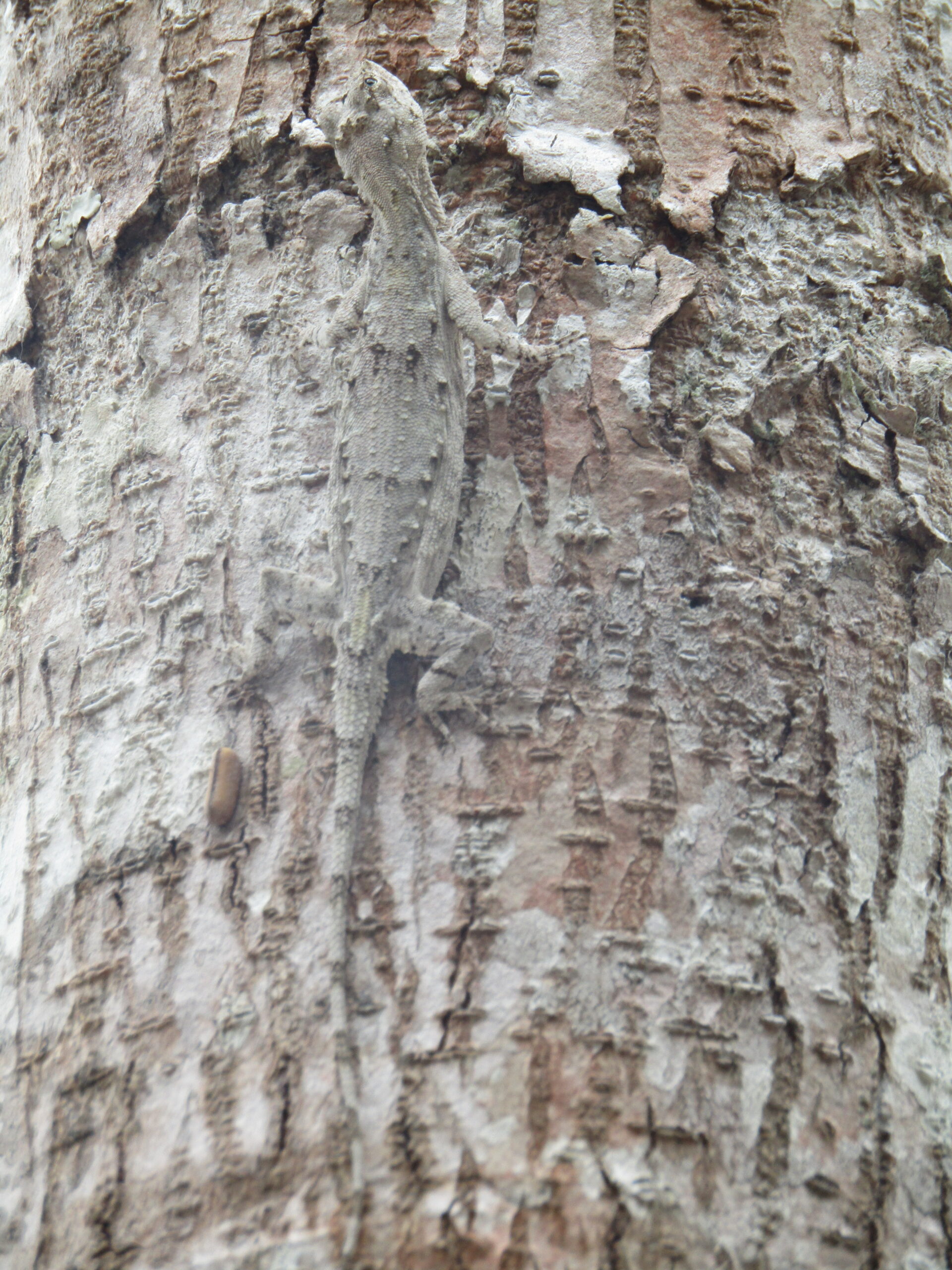WIldlife of Thailand
When in Thailand, I was surprised and amazed to find how many national parks they have, some of which have a great diversity of wildlife and preserved habitat. Here, I describe my visits to three Thai national parks, each with a different style of welcoming guests, and attractions to see inside.
Kaeng Krachan

The stay at Kaeng Krachan consisted of two nights camping, at two different sites. Everything was arranged at the park headquarters before entry, where you could pay and hire equipment including a tent. They also offered a driver-for-hire, for transport between from the entrance to the two camp sites, over two days.
There were very few visitors inside the park in early December. In one of the cafes they have at the campsites – where you can purchase a decent meal – there was a group of zoologists. They were observing wildlife, and kindly shared footage they had obtained from camera traps in the park. Sightings included elephants, sun bears, leopards – and a tiger! All in the area we were camping in…
Primates
You will undoubtedly come across one of our distant relatives in the park, whether it be a gibbon, langur or macaque. Langurs can be spotted high up in the branches, commonly in the more elevated areas of the park. You will certainly hear the call of the gibbon, which can be heard communicating from miles away. Even more impressive is seeing the speed at which they swing through the trees (up to 55km an hour).




Peace
Aside from the wildlife, the park is a tranquil sanctuary in Thailand. If you’re lucky, the only sounds you’ll hear in the evening are the birds. You may also be woken up by the call of a gibbon, or playful monkeys playing in the branches above.

The leopard that got away…
On a walk along the trail that runs through the park, out of nowhere, a leopard appeared about 70/80 metres away. Out of shock, I exclaimed aloud – which alerted the bit cat. Before I could reach for my camera, the leopard had skipped off into the undergrowth. Although the fact the leopard retreating was safer than it approaching, I can’t help retain some disappointment that I wasn’t able to get the encounter on camera. I’m grateful for the sighting, though.
A few months before my visit, however, there had been a fatal incident involving a young American girl and a herd of elephants. It’s a reminder, as wonderful as it is to see animals in their natural habitat, roaming free, it is not free of risk. Always take precautions in the wild.
Khao Yai

Khao Yai is one of the biggest national parks in Thailand, and is less than three hours’ drive from Bangkok. It sees a lot of visitors, partly because there’s a main road running through it.
I had a day trip here, on a hired scooter from the hostel I was staying. And the day started with the scariest moment of my life. A moment in which I genuinely felt my life was in danger – with good reason, given the size of the beast that was coming towards me.
Oh, Nelly
I was driving a hired scooter to the park, arriving before sunrise. I went up and up as the park elevates above the surrounding area. I knew I was coming close to the watchtower – my first stop – as there were two speed bumps in the road.
I slowed down to go over the first, and as I did, I heard a lot of rustling in the long grass to the side of the road. I looked up, and saw a huge grey shape coming out at me, along with a deafening sound of a trumpet.
Close call
At this point, I must have ran on instinct and adrenaline. I accelerated quickly and rode over the next speed bump, then pulled into where I saw a group standing next to the car – they had seen the whole thing – and told me to turn the engine off. The huge elephant stood back on the road, around fifty metres away, almost at a stand off. It then blew its trunk again, and made a feint towards us. Seeing this, the group bolted into their car, leaving me alone with my scooter and nowhere to run to.
Luckily, the elephant came no further, and walked off into the grass from whence it came. The group, reappearing from the safety of their car, explained to me they had seen a family of elephants with a baby crossing the road shortly before I arrived. My scooter must have been too close to the mother, and she reacted. They all found it hilarious. My heart was racing for the next two hours.
The rest of the day was a lot more relaxed, and full of safer wildlife encounters. This park homes many of Thailand’s most fantastic and endangered animals, and I managed to see a great variety in a single day.
The residents of Khao Yai





Exploring the park
There are plenty of places to stop for a wander. Accommodation and eateries are available, too. You have to be cautious, given the amount of wildlife in the park, and that some of the animals are very dangerous. Most will leave you alone, if you leave them alone.
A Siamese crocodile, considered critically-endangered, was involved in a news story just a few weeks before my visit… If it wasn’t obvious already, it is ill-advised to attempt a selfie near a predator as large as this.
Some of the smaller, friendly animals have been accustomed to human presence. They may even pose for a photo. But if you see an elephant on the road, it is probably best to give way.
Driving through the park, there are plenty of places to stop for a wander. Accommodation and eateries are available, too. You have to be cautious, given the amount of wildlife in the park, and that some of the animals are very dangerous. Most will leave you alone, if you leave them alone.
A Siamese crocodile, considered critically-endangered, was involved in a news story just a few weeks before my visit… If it wasn’t obvious already, it is ill-advised to attempt a selfie near a predator as large as this.
Some of the smaller, friendly animals have been accustomed to human presence. They may even pose for a photo. But if you see an elephant on the road, it is probably best to give way.




Outside of a wildlife refuge, you would expect to see people enjoying a waterfall like this… Instead, in this Thai national park, a troop of monkeys have claimed it for their own.
Unlike some monkeys in Thailand, these didn’t seem to be dependent on human food. Other popular tourist sights such as temples often have hoards of monkeys that will swarm visitors, expecting handouts. These were chilling.



Kui Buri

When I visited in 2014, this park seemed to be starting to creating a name for itself. In fact, there didn’t seem to be anyway into the park from the nearby cities, other than with a tour. Unsurprisingly, it wasn’t hard to hitch a ride closer to the park, given how nice the people of Thailand are.
Completely unprepared, a local host offered a room at their guesthouse a short drive from the park. The park itself was accessed through guided tours, on the back of a pickup truck. Understandable, when you realise how easily it is to stumble upon one its large residents.

The tour
We were taken on a short drive to some open areas, including a watchtower, in which to spot wildlife. We had seen one elephant, although it was from around 200 metres away, and partially hidden by the trees. Sadly, the gaur escaped me on this visit. However…
At the end of the first afternoon tour, the guide either heard a rustle or saw movement in the growth. As we stopped, we parked up by the opening of the watering hole.
Right on cue, these two elephants came striding out of the bushes, no more than 50 metres away.
We could safely watch them, completely undisturbed, drinking and eating at the water’s edge as the sun went down.





Back again
A second tour, the next afternoon, also gifted the opportunity to see these amazing animals in their natural habitat. Unfortunately, Thailand has been known to keep animals in awful conditions (I’m thinking of the Tiger Temple). Another big draw for Westerners seems to be washing and bathing elephants.
While some of those elephants may be in a sanctuary after being rescued, there are still instances of working elephants all over Asia. The problem of keeping these large beasts captive is that it’s almost impossible to have them working, as well as allowing them the time they need to eat to maintain their huge size. Wild elephants spend a considerable amount of their time grazing. It’s just not possible if they’re carrying people on their back and offering tours for them to do this. And they suffer as a result.
This is why I choose to try to see elephants in the wild, without certainty of it happening, even just for a short glimpse. After having seen them in the wild, and free, I wouldn’t have done it differently.